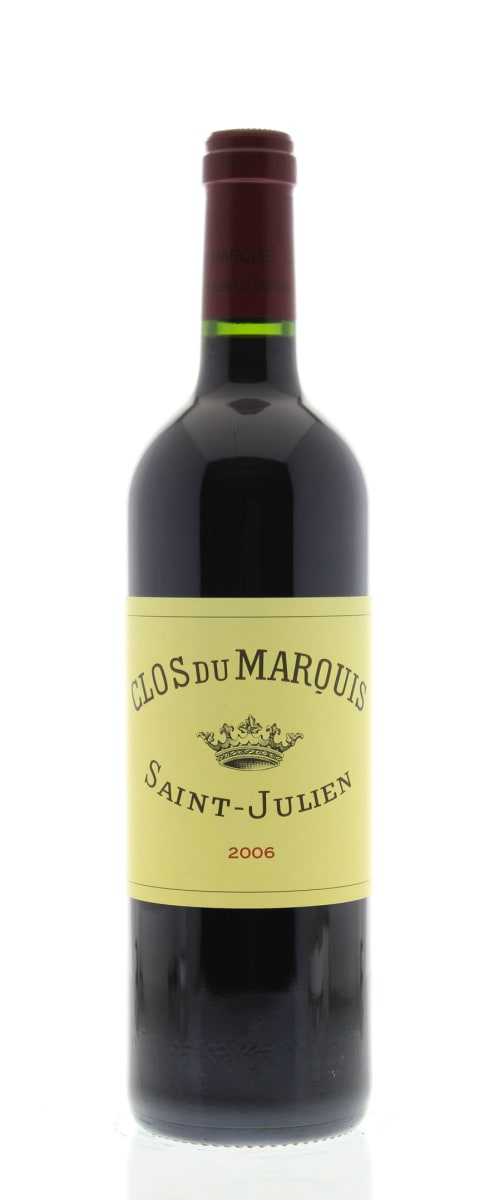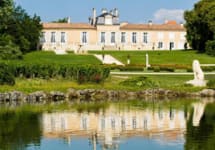Clos du Marquis 2006
-
Wine
Spectator -
Wine
Enthusiast -
Robert
Parker




Product Details
Your Rating
Somm Note
Winemaker Notes
Professional Ratings
-
Wine Spectator
Offers violet and blackberry on the nose, with tar. Full-bodied, with velvety tannins and a fruity, minerally aftertaste. Long and silky. Very serious for the vintage. Best after 2013.
-
Wine Enthusiast
A beautifully perfumed, dark-colored wine, bursting with black plums and violet perfumes. It is, on the surface, delicious, but taste beneath that and it becomes complex and dark, with immense but velvet tannins, suggesting considerable potential.
-
Robert Parker's Wine Advocate
As usual, the second wine, the 2006 Clos du Marquis, exhibits a character similar to the grand vin, but it is a more fruit-forward effort with sweeter tannins, and a more precocious, evolved personality. With super intense black cherry and cedary notes intermixed with hints of licorice and barrique, this deep, medium to full-bodied, velvety-textured wine is ideal for consumption over the next 15+ years.
Other Vintages
2024-
James
Suckling -
Robert
Parker - Vinous
-
James
Suckling - Vinous
- Decanter
-
Jeb
Dunnuck -
Robert
Parker
-
Jeb
Dunnuck -
James
Suckling -
Robert
Parker -
Wine
Spectator
-
James
Suckling -
Wine
Enthusiast - Decanter
-
Robert
Parker -
Jeb
Dunnuck
-
Jeb
Dunnuck -
James
Suckling -
Wine
Enthusiast -
Wine
Spectator -
Robert
Parker - Decanter
-
Wine
Enthusiast -
Jeb
Dunnuck -
Robert
Parker -
James
Suckling -
Wine
Spectator - Decanter
-
Jeb
Dunnuck -
Wine
Enthusiast -
James
Suckling -
Robert
Parker -
Wine
Spectator
-
James
Suckling -
Jeb
Dunnuck -
Wine
Spectator -
Robert
Parker -
Wine
Enthusiast - Decanter
-
James
Suckling -
Wine
Enthusiast -
Robert
Parker -
Jeb
Dunnuck - Decanter
-
Wine
Spectator
-
James
Suckling -
Wine
Spectator -
Wine
Enthusiast -
Robert
Parker -
Jeb
Dunnuck - Decanter
-
Wine
Enthusiast -
Robert
Parker -
James
Suckling -
Wine
Spectator
-
Wine
Enthusiast -
James
Suckling - Vinous
-
Wine
Spectator
-
James
Suckling -
Wine
Enthusiast -
Wine
Spectator -
Robert
Parker
-
James
Suckling -
Wine
Enthusiast -
Robert
Parker -
Wine
Spectator
-
James
Suckling -
Wine
Enthusiast -
Wine
Spectator
-
Wine
Enthusiast -
Robert
Parker
-
Wine
Spectator -
James
Suckling -
Jeb
Dunnuck -
Robert
Parker
-
Wine
Spectator
-
Wine
Spectator -
Robert
Parker -
Wilfred
Wong
-
Robert
Parker
-
Wine
Spectator


Léoville-Las Cases was once part of a much larger estate until the time of the French Revolution when a portion of this estate was separated into what is today Chateau Léoville-Barton. In 1840, the estate was again divided and land that would eventually become Chateau Léoville-Poyferré was split off. Since the mid 20th century the Delon family have been owners of this estate.

One of the world’s most classic and popular styles of red wine, Bordeaux-inspired blends have spread from their homeland in France to nearly every corner of the New World. Typically based on either Cabernet Sauvignon or Merlot and supported by Cabernet Franc, Malbec and Petit Verdot, the best of these are densely hued, fragrant, full of fruit and boast a structure that begs for cellar time. Somm Secret—Blends from Bordeaux are generally earthier compared to those from the New World, which tend to be fruit-dominant.

An icon of balance and tradition, St. Julien boasts the highest proportion of classed growths in the Médoc. What it lacks in any first growths, it makes up in the rest: five amazing second growth chateaux, two superb third growths and four well-reputed fourth growths. While the actual class rankings set in 1855 (first, second, and so on the fifth) today do not necessarily indicate a score of quality, the classification system is important to understand in the context of Bordeaux history. Today rivalry among the classed chateaux only serves to elevate the appellation overall.
One of its best historically, the estate of Leoville, was the largest in the Médoc in the 18th century, before it was divided into the three second growths known today as Chateau Léoville-Las-Cases, Léoville-Poyferré and Léoville-Barton. Located in the north section, these are stone’s throw from Chateau Latour in Pauillac and share much in common with that well-esteemed estate.
The relatively homogeneous gravelly and rocky top soil on top of clay-limestone subsoil is broken only by a narrow strip of bank on either side of the “jalle,” or stream, that bisects the zone and flows into the Gironde.
St. Julien wines are for those wanting subtlety, balance and consistency in their Bordeaux. Rewarding and persistent, the best among these Bordeaux Blends are full of blueberry, blackberry, cassis, plum, tobacco and licorice. They are intense and complex and finish with fine, velvety tannins.
